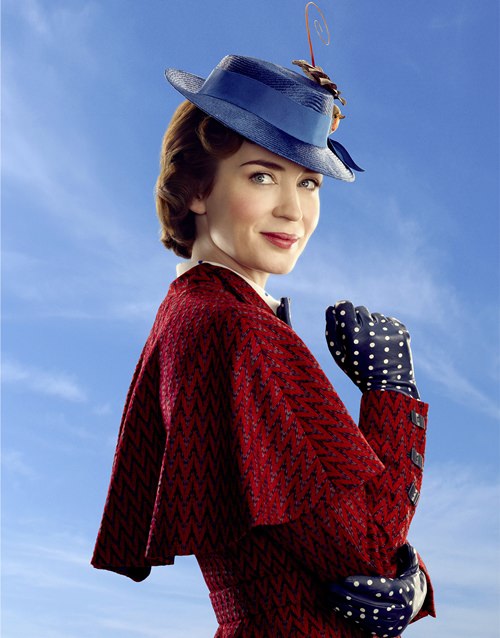
Los Angeles (AP) – In the half-century since the original “Mary Poppins” debuted, we’ve learned a lot about refined sugar, frankly none of it good. Doctors tell us it can lead to obesity, heart disease and all sorts of other detriments to our health.
But let’s face it, there are times when a little sugar — oh what the heck, let’s say a spoonful — is just what we need, if not for health then for happiness. So it’s sweet news indeed that “Mary Poppins Returns,” a sequel 54 years in coming, provides just that spoonful of happiness in the form of Emily Blunt, practically perfect in every way as the heir to Julie Andrews.
“Spit spot!” ”Pish Posh!” ”Jigetty Jog!” (Did we spell that right?) These Poppins-isms slip effortlessly off Blunt’s tongue. It’s also no simple feat to gaze at one’s reflection and say “practically perfect in every way” and not seem egotistical, but Blunt’s easy warmth and charm shine through.
Of course she can also sing, and dance, with partners both live and animated. And she’s funny — witness her priceless indignation when a child asks how much she weighs. But then she can spin on a dime and convey that steely Poppins nerve, that sense that in a crisis, she knows exactly what must be done, and everybody else had better stand aside.
There’s further happy news here: It’s not just Blunt that’s at the top of her game in this thoroughly delightful enterprise by director Rob Marshall and a crack team of artists devoted to both honoring a time-worn classic and finding something new to say.
The visuals are lovely, from the oil paintings in the opening credits to the balloon-filled spring fair at the end. And Sandy Powell’s costumes are fabulous, especially the reds and blues and stripes and polka dots that adorn Mary, from her straw-hatted head to her turned-out feet (What we wouldn’t give for one of those slender-waisted, caped overcoats, or polka-dot bow ties). And those candy-hued clothes that Mary, Jack and the Banks kids wear in the centerpiece scene mixing live action and animation? They’re literally hand-painted, to delectable effect.
Blunt’s star power is complemented here by appealing turns from Lin-Manuel Miranda as the afore-mentioned Jack, a kind-hearted lamplighter who once worked for Bert the chimney sweep (aka Dick Van Dyke); Ben Whisham and Emily Mortimer as the elder Banks children, a slimy Colin Firth as the bank chief, and, for icing on the cake, a flame-haired Meryl Streep as Mary’s vaguely Eastern European cousin Topsy (“Vat do you VANT?”).
Then there’s the icing on the icing: a cameo by Van Dyke himself, still spry at 92, that is hands-down the emotional peak of the film — even before he starts to twinkle those toes.
The setting is Depression-era London, where widowed Michael lives with his three young children at 17 Cherry Tree Lane, struggling to stay afloat. Sister Jane, a labor organizer, lives in a flat across town.
As we begin, Michael learns he’s behind on loan payments, and the bank wants to take his house. He’s given five days to find proof that his father owned shares there, which could save the home. Searching desperately, he comes across an old kite but tosses it in the trash.
Luckily it’s a windy day, and who flies in with that kite? Yep, Mary, emerging from the sky with her bottomless bag and umbrella (If you’re crying already here, and you might be, you’re in trouble). “It’s wonderful to see you,” exclaim a shocked Michael and Jane. “Yes it is, isn’t it,” Mary replies.
Just like that, Mary’s sliding up the banister again. First order of business: the children’s bath, which turns into a wild adventure down the drain and into the colorful sea, flying dolphins and all.
“Can You Imagine That?” Mary sings, one of the catchy original songs by Marc Shaiman and Scott Wittman. There’s also the mournful “The Place Where Lost Things Go,” about loss, and Streep’s tour de force, “Turning Turtle,” and the brassy performance number “A Cover is Not the Book.” Each song has its spiritual antecedent in the original film, including the lamplighters’ dance number “Trip a Little Light Fantastic,” a nod to “Step in Time.”
As for Miranda, though the role he’s given could have used more of a backstory, his presence injects a warm and sunny vibe into gray Depression-era London, and it’s totally infectious. His Cockney accent is better than his predecessor’s, too, and it’s nice that he gets to rap a bit in the animated fantasy sequence, as did Van Dyke (sort of) in the original. Mortimer and especially Whisham are both touching in roles that could have felt perfunctory.
Perhaps no more explanation is necessary — after all, as Jack says, “Mary Poppins never explains anything.” Will we meeting her yet again? Who knows. But it was wonderful to see her, especially in Blunt’s loving hands.
“Yes it was, wasn’t it,” she’d surely reply.
“Mary Poppins Returns,” a Walt Disney Studios release, is rated PG by the Motion Picture Association of America “for some mild thematic elements and brief action.” Running time: 130 minutes. Three and a half stars out of four.
 |
 |





